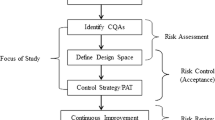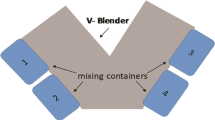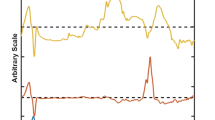Abstract
The purpose of this study was to utilize near-infrared spectroscopy and chemical imaging to characterize extrusion-spheronized drug beads, lipid-based placebo beads, and modified release tablets prepared from blends of these beads. The tablet drug load (10.5–19.5 mg) of theophylline (2.25 mg increments) and cimetidine (3 mg increments) could easily be differentiated using univariate analyses. To evaluate other tablet attributes (i.e., compression force, crushing force, content uniformity), multivariate analyses were used. Partial least squares (PLS) models were used for prediction and principal component analysis (PCA) was used for classification. The PLS prediction models (R 2 > 0.98) for content uniformity of uncoated compacted theophylline and cimetidine beads produced the most robust models. Content uniformity data for tablets with drug content ranging between 10.5 and 19.5 mg showed standard error of calibration (SEC), standard error of cross-validation, and standard error of prediction (SEP) values as 0.31, 0.43, and 0.37 mg, and 0.47, 0.59, and 0.49 mg, for theophylline and cimetidine, respectively, with SEP/SEC ratios less than 1.3. PCA could detect blend segregation during tableting for preparations using different ratios of uncoated cimetidine beads to placebo beads (20:80, 50:50, and 80:20). Using NIR chemical imaging, the 80:20 formulations showed the most pronounced blend segregation during the tableting process. Furthermore, imaging was capable of quantitating the cimetidine bead content among the different blend ratios. Segregation testing (ASTM D6940-04 method) indicated that blends of coated cimetidine beads and placebo beads (50:50 ratio) also tended to segregate.













Similar content being viewed by others
REFERENCES
FDA, Guidance for Industry: PAT- a framework for innovative pharmaceutical development, manufacturing and quality assurance, September 2004. [cited; Available from: http://www.fda.gov/cder/ops/pat.htm].
Rantanen, Rasanen E, Tenhunen J, Kansakoski M, Mannermaa J, Yliruusi J. In-line moisture measurement during granulation with a four-wavelength near-infrared sensor: an evaluation of particle size and binder effects. Eur J Pharm Biopharm. 2000;50:271–6.
Reich G. Near-infrared spectroscopy and imaging: basic principles and pharmaceutical applications. Adv Drug Deliv Rev. 2005;57:1109–43.
Roggo Y, Chalus P, Maurer L, Lema-Martinez C, Jent N. A review of near infrared spectroscopy and chemometrics in pharmaceutical technologies. J Pharm Biomed Anal. 2007;44(3):683–700.
Yu X, Lionberger RA, Raw AS, D'Costa R, Wu H, Hussain AS. Applications of process analytical technology to crystallization processes. Adv Drug Deliv Rev. 2004;56:349–69.
Sandler N, Rantanen J, Heinamaki J, Romer M, Marvola M, Yliruusi J. Pellet manufacturing by extrusion-spheronization using process analytical technology. AAPS PharmSciTech. 2005;6(2):E174–83.
Drennen JK, Lodder RA. Nondestructive near-infrared analysis of intact tablets for determination of degradation products. J Pharm Sci. 1990;79:622–7.
Dziki W, Bauer JF, Szpylman JJ, Quick JE, Nichols BC. The use of near-infrared spectroscopy to monitor the mobility of water within the sarafloxacin crystal lattice. J Pharm Biomed Anal. 2000;22(5):829–48.
Zhou X, Hines P, Borer ME. Moisture determination in hygroscopic drug substances by near infrared spectroscopy. J Pharm Biomed Anal. 1998;17:219–25.
Frake P, Greenhalgh D, Grierson SM, Hempemstall JM, Rud DR. Process control and endpoint determination of a fluid bed granulation by application of near infrared spectroscopy. Int J Pharm. 1997;151:75–80.
Watano S, Takashima H, Sato Y, Yasutomo T, Miyanami K. Measurement of moisture content by IR sensor in fluidized bed granulation: effects of operating variables on the relationship between granule moisture content and absorbance IR spectra. Chem Pharm Bull. 1996;44:1267–9.
Gupta A, Peck GE, Miller RW, Morris KR. Real-time near-infrared monitoring of content uniformity, moisture content, compact density, tensile strength, and Young’s modulus of roller compacted powder blends. J Pharm Sci. 2005;94(7):1589–97.
Han SM, Faulkner PG. Determination of SB 216469-S during tablet production using near-infrared reflectance spectroscopy. J Pharm Biomed Anal. 1996;14:1681–9.
O'Neil AJ, Jee RD, Moffat AC. The application of multiple linear regression to the measurement of the median particle size of drugs and pharmaceutical excipients by near- infrared spectroscopy. Analyst. 1998;123:2297–302.
O'Neil AJ, Jee RD, Moffat AC. Measurement of cumulative particle size distribution of microcrystalline cellulose using near infrared reflectance spectroscopy. Analyst. 1999;124:33–6.
Broad NW, Jee RD, Moffat AC, Smith MR. Application of transmission near- infrared spectroscopy to uniformity of content testing of intact steroid tablets. Analyst. 2001;126(12):2207–11.
Chen Y, Thosar SS, Forbess RA, Kemper MS, Rubinovitz RL, Shukla AJ. Prediction of drug content and hardness of intact tablets using artificial neural network and near-infrared spectroscopy. Drug Dev Ind Pharm. 2001;27:623–31.
Cogdill RP, Anderson CA, Delgado M, Chisholm R, Bolton R, Herkert T, et al. Process analytical technology case study: part II. Development and validation of quantitative near-infrared calibrations in support of a process analytical technology application for real-time release. AAPS PharmSciTech. 2005;6(2):E273–83.
Laasonen M, Harmia-Pulkkinen T, Simard C, Rasanen M, Vuorela H. Development and validation of a near-infrared method for the quantitation of caffeine in intact single tablets. Anal Chem. 2003;75(4):754–60.
Li T, Donner AD, Choi CY, Frunzi GP, Morris KR. A statistical support for using spectroscopic methods to validate the content uniformity of solid dosage forms. J Pharm Sci. 2003;92:1526–30.
Trafford AD, Jee RD, Moffat AC, Graham P. A rapid quantitative assay of intact paracetamol tablets by reflectance near-infrared spectroscopy. Analyst. 1999;124(2):163–7.
Tatavarti A, Fahmy R, Wu H, Hussain AS, Marnane W, Bensley D, et al. Assessment of NIR spectroscopy for nondestructive analysis of physical and chemical attributes of sulfamethazine bolus dosage forms. AAPS PharmSciTech. 2005;6(1):E91–9.
Gottfries J, Depui H, Fransson M, Jongeneelen M, Josefson M, Langkilde FW, et al. Vibrational spectroscopy for the assessment of active substance in metroprolol tablets: a comparison between transmission and diffuse reflectance near-infrared spectrometry. J Pharm Biomed Anal. 1996;14:1495–503.
Ji Q, Tumuluri V, Wang W, Teelucksingh J, Mecadon M, Vegesna R. Rapid content uniformity determination of low dose TCH346 tablets by NIR. Am Pharm Rev. 2006;9(5):20–6.
Thosar SS, Forbess RA, Ebube NK, Chen Y, Rubinovitz RL, Kemper MS, et al. A comparison of reflectance and transmittance near- infrared spectroscopic techniques in determining drug content in intact tablets. Pharm Dev Technol. 2001;6(1):19–29.
Morisseau KM, Rhodes CT. Near-infrared spectroscopy as a nondestructive alternative to conventional tablet hardness testing. Pharm Res. 1997;14:108–11.
Otsuka M, Yamane I. Prediction of tablet hardness based on near infrared spectra of raw mixed powders by chemometrics. J Pharm Sci. 2006;95(7):1425–33.
Kirsch JD, Drennen JK. Nondestructive tablet hardness testing by near-infrared spectroscopy: a new and robust spectral best-fit algorithm. J Pharm Biomed Anal. 1999;19:351–62.
Donoso M, Kildsig DO, Ghaly ES. Prediction of tablet hardness and porosity using near-infrared diffuse reflectance spectroscopy as a nondestructive method. Pharm Dev Technol. 2003;8(4):357–66.
Guo J, Skinner GW, Harcum WW, Malone JP, Weyer LG. Application of near- infrared spectroscopy in the pharmaceutical dosage form. Drug Dev Ind Pharm. 1999;25(12):1267–70.
Norris KH, Williams PC. Optimization of mathematical treatments of raw near- infrared signal in the measurement of protein in hard red spring wheat. I. Influence of particle size. Cereal Chem. 1984;61:158–65.
Xie L, Wu H, Shen M, Augsburger LL, Lyon RC, Khan MA, et al. Quality-by-design: effects of testing parameters and formulation variables on the segregation tendency of pharmaceutical powder measured by the ASTM D 6940–04 segregation tester. J Pharm Sci. 2007;97(10):4485–97.
Bokobza L. Near infrared spectroscopy. J Near Infrared Spectrosc. 1998;6:3–17.
Miller CE. Chemometrics in process analytical chemistry. In: Bakeev KA, editor. Process analytical technology. Oxford: Blackwell Publishing; 2005. p. 226–328.
Workman JJ. NIR spectroscopy calibration basics. In: Burns DA, Ciurczak EW, editors. Handbook of near-infrared analysis. New York: Marcel Dekker Inc; 2001.
Lyon RC, Lester DS, Lewis EN, Lee E, Yu LX, Jefferson EH, et al. Near- infrared spectral imaging for quality assurance of pharmaceutical products: analysis of tablets to assess powder blend homogeneity. AAPS PharmSciTech. 2002;3(3):1–15.
Lee E, Huang WX, Chen P, Lewis EN. High-throughput analysis of pharmaceutical tablet content uniformity by near-infrared chemical imaging. Spectroscopy. 2006;21:24–32.
Lyon RC, Jefferson EH, Ellison CD, Buhse LF, Spencer JA, Nasr MM, et al. Exploring pharmaceutical applications of near-infrared technology. Am Pharm Rev. 2003;6:62–70.
Westenberger BJ, Ellison CD, Fussner AS, Jenny S, Kolinski RE, Lipe TG, et al. Quality assessment of internet pharmaceutical products using traditional and non-traditional analytical techniques. Int J Pharm. 2005;306:56–70.
Cogdill RP, Drennen JK. Spectroscopy of pharmaceutical solids. In: Brittain HG, editor. Near-infrared spectroscopy. New York: Taylor and Francis; 2006. p. 313–412.
Hamad ML, Ellison CD, Khan MA, Lyon RC. Drug product characterized by macropixel analysis of chemical images. J Pharm Sci. 2007;96(12):3390–401.
Torrado JJ, Augsburger LL. Tableting of multiparticulate modified release systems. In: Hoag SW, Augsburger LL, editors. Pharmaceutical dosage forms: tablets volume 2. 3rd ed. New York: Informa Healthcare; 2008.
Cantor SL, Hoag SW, Augsburger LL. Formulation and characterization of a compacted multiparticulate system for modified release of water-soluble drugs—part I acetaminophen. Drug Dev Ind Pharm. 2009;35(3):337–51.
Cantor SL, Hoag SW, Augsburger LL. Formulation and characterization of a compacted multiparticulate system for modified release of water-soluble drugs—part II theophylline and cimetidine. Drug Dev Ind Pharm. 2009;35(5):568–82.
Cantor SL, Hoag SW, Augsburger LL. Evaluation of the mechanical properties of extrusion-spheronized beads and multiparticulate systems. Drug Dev Ind Pharm. 2009;35(6):683–93.
ASTM Standard D6940-04 (2004). Standard practice for measuring sifting segregation tendencies of bulk solids. West Conshohocken, PA.
Beebe KR, Pell RJ, Seasholtz MB. Chemometrics: a practical guide. New York: Wiley; 1998.
Savitzky A, Golay MJE. Smoothing and differentiation of data by simplified least squares procedures. Anal Chem. 1964;36:1627–39.
Shenk JS, Workman JJ, Westerhaus MO. Application of NIR spectroscopy to agricultural products. In: Burns DA, Ciurczak EW, editors. Handbook of near infrared analysis. New York: Marcel Dekker Inc; 2001. p. 419–74.
Personal Communication, November 2006, FOSS NIRSystems, Laurel, Maryland
United States Pharmacopeia 29/NF 24. 2009, Rockville, MD: United States Pharmacopeial Convention.
Short SM, Cogdill RP, Wildfong PLD, Drennen III JK, Anderson CA. A near-infrared spectroscopic investigation of relative density and crushing strength in four-component compacts. J Pharm Sci. 2009;98(3):1095–109.
FDA, ICH Quality Guidelines for Method Validation, Q2A, Text on Validation of Analytical Procedures, and Q2B, Validation of Analytical Procedures: Methodology, November 1996, [cited; Available from:http://www.ifpma.org/ich5.html].
Blanco M, Alcala M, Gonzalez JP, Torras E. A process analytical technology approach based on near infrared spectroscopy: tablet hardness, content uniformity, and dissolution test measurements of intact tablets. J Pharm Sci. 2006;95(10):2137–44.
Blanco M, Alcala M. Content uniformity and tablet hardness testing of intact pharmaceutical tablets by near infrared spectroscopy: a contribution to process analytical technologies. Anal Chim Acta. 2006;557(1–2):353–9.
ACKNOWLEDGMENTS
The opinions expressed in this article are those of the authors and do not necessarily reflect the views and policies of the US Food and Drug Administration. The authors gratefully acknowledge research funding from the Parenteral Drug Association (PDA) Fellowship and the Maryland Consortium for Industrial Pharmaceutics and Training (CIPET) as well as the generous donation of ethylcellulose from Dow Chemical Co. and Eudragit® samples from Evonik Röhm Degussa GmbH.
Author information
Authors and Affiliations
Corresponding author
Rights and permissions
About this article
Cite this article
Cantor, S.L., Hoag, S.W., Ellison, C.D. et al. NIR Spectroscopy Applications in the Development of a Compacted Multiparticulate System for Modified Release. AAPS PharmSciTech 12, 262–278 (2011). https://doi.org/10.1208/s12249-010-9580-z
Received:
Accepted:
Published:
Issue Date:
DOI: https://doi.org/10.1208/s12249-010-9580-z




